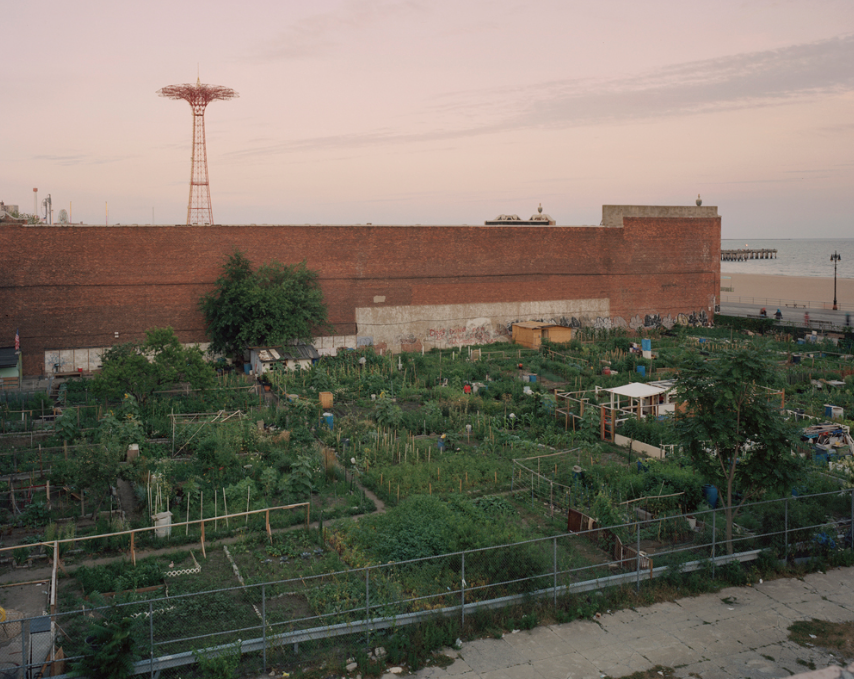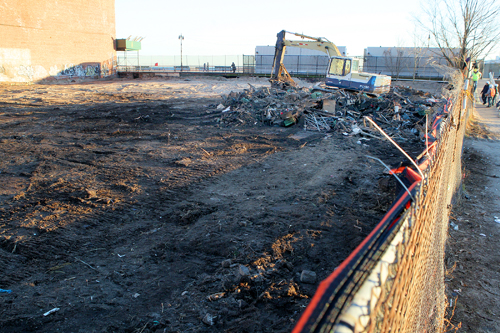Join Boardwalk Community Garden and NYCCGC at their court hearing:
Tuesday, June 10, 9:30AM
Brooklyn State Supreme Court
360 Adams Street, Courtroom 441
By Raymond Figueroa-Reyes and Aziz Dekhan
At approximately 4:00 am on December 28, 2013, bulldozers, owned by the developer iStar Financial, Inc. and sanctioned by the City, leveled the Boardwalk Community Garden, a beloved and vibrant hub of collective efficacy that provided many benefits to the surrounding community in Coney Island. The City's plans have called for paving over the entire area of the Boardwalk Community with concrete in order to build an outdoor for-profit amphitheater, a “Seaside Park and Community Arts Center.”
We are not opposed to the amphitheater project per se. And we certainly are not opposed to the revitalization of the Coney Island community. What we are concerned with and specifically opposed to is that the planned location for this proposed project calls for the development to take place on the site of a designated New York City Parkland that is being used as a public community garden.
The People’s Lawsuit and Upcoming Court Date
On April 18, 2014, the New York City Community Gardening Coalition and the People’s Coalition of Coney Island filed a lawsuit against the City of New York and iStar Financial, Inc. and its subsidiaries on behalf of the garden. In the lawsuit, we cite issues with the City Environmental Quality Review (CEQR) process used to determine what effect the project would have on the surrounding environment. And, we hold that the initial Environmental Impact Statement (EIS), which is meant to disclose the social, economic, and environmental impacts of a project, was based on limited and inaccurate information.[i]
On April 29, 2014, members of the Coney Island Boardwalk Community Garden reached a temporary agreement with the City and iStar Financial, Inc., to postpone the planned construction of a $53 million amphitheater project pending the lawsuit. In the agreement, the City and iStar agree that they do not intend to pursue any major construction on the site of the Boardwalk Garden, which currently sits unused and fenced-in, until at least the upcoming court date of June 10, and that they will provide the petitioners with ten days’ notice if they plan to perform any activity on the site beyond soil sampling or other non-invasive activities.
The Boardwalk Community Garden, a True Community Anchor
Community gardens in New York City are true community anchors. They provide a common ground for people from all walks-of-life to come together and collectively be creative and productive contributors to a meaningful place in their lives. Community gardens provide valuable space for subsistence agriculture as well as for food production in the more traditional market-oriented sense.
Community gardens fulfill a variety of valuable social, cultural, economic and environmental benefits at little cost - pennies on the municipal services dollar.[ii] Community gardens allow for important human rights to be respected, i.e., the right for people to be productively engaged in meaningfully self-determining ways which honor and preserve their sense of human dignity. Even more poignantly, community gardens are a way for our underserved and marginalized communities to fight back against the systemic injustices of structural oppression including Depression-era levels of poverty and unemployment. The vast majority of community gardens can be found in 'poor' areas of the city, which have higher rates of chronic diseases including asthma and lower rates of open space equity. From an indigenous perspective, community gardens allow our communities to heal and our people to recover a humanizing sense of self and dignity in what is otherwise a very hard city.
The Boardwalk Community Garden in Coney Island represents one such bastion of community resilience and sustainability. At its peak this past growing season, in the summer of 2013, this one-acre urban subsistence farm was bursting with fecundity - with plants, flowers, fruits, and vegetables, resulting from the respective efforts of its diverse members including ethnic Russians, Caribbean Islanders, and Mexican immigrants as well as native born Puerto Ricans and African Americans all cultivating, harvesting, and sharing its bumper crop bounty with the surrounding community.
The City in concert with the real estate developer, iStar Financial, carried out this act of violence against a much beloved community garden, and did so in a community that is already engaged in the day-in & day-out economic grind associated with poverty and unemployment, i.e., the struggle for salvaging its sense of human dignity as it pursued decency in its living conditions.
Short of having an extraordinarily attuned sense of compassion, it is nearly impossible to sense and to fully grasp the depth of pain that this wanton act of violence has caused unless one otherwise lives in this day-in/day-out existence of struggling-to-survive economically. Through this community garden, local residents were attempting to live in peace and in harmony – growing their food and their medicine – making up for the shortfalls/cuts in their food stamps (as they simultaneously struggle to pay their rent), making up for the shortfalls in their health insurance (or no health insurance), and/or in their pensions (or no pensions).
These gardeners, who have for years improved and gardened this seaside plot, have courageously faced extraordinary adversity in recent years. In addition to dealing with the daily exigencies of poverty, the community has had to put up with an aging sewer infrastructure and the concomitant flooding problems endemic to this West Coney Island area. To be sure, the gardeners were forced to rebuild their garden after it was destroyed by Hurricane Sandy. By the summer following the storm, after clearing tons of sand and debris, the community successfully returned the garden to its former bounty, only to see the City later step in and do what Hurricane Sandy could not—prevent them from using and enjoying their public space.


Photos, from top: Boardwalk Community Garden, source – Rob Stephenson, Five Borough Farm, 2012; In December 2013, credit Steve Solomonson, source – brooklynpaper.com
Support the Boardwalk Community Garden
This is a “People’s Lawsuit” and we need your support! On, Tuesday, June 10th, we’ll appear in Kings County Supreme Court and urge you to make an impression on the judge by helping us pack the courtroom in solidarity with the Boardwalk Community Garden. While this court case is about a community garden in a struggling neighborhood in West Coney Island in Brooklyn, it is also about our solidarity as a people - as a community-in-struggle wherever we may find ourselves geographically dispersed. What happened in Brooklyn can happen anywhere in the Bronx, in El Barrio, in Queens, etc.
The outcome of this case has the potential to set precedents for how community gardens throughout the city are regarded by the City and subsequently treated. We ask the City to restore Boardwalk Community Garden as a garden for growing fresh fruit and vegetables.
You can help us convey this message by packing the courtroom on Tuesday, June 10th. In addition, we’re hosting a “Back to the Garden” fundraiser the evening of June 10th. Donations raised via the fundraiser will help us cover the legal costs that are essential to take on this fight and win.
Raymond Figueroa-Reyes, Jr. and Aziz Dehkan are the President and Executive Director, respectively, of the NYC Community Garden Coalition.
[i] Read the NYCCGC’s request to the New York City Council for a new Environmental Impact Statement (provide link)
[ii] Benefits of Community Gardens
Community gardens in New York City are true community anchors. They provide a common ground for people from all walks-of-life to come together and collectively be creative and productive contributors to a meaningful place in their lives. Community gardens provide valuable space for subsistence agriculture as well as for food production in the more traditional market-oriented sense. Community gardens offer many additional benefits:
Value-adding ecological services of community gardens:
- Composting as a natural mechanism for carbon sequestration and footprint reduction
- Bio- and phyto-remediation of urban soils including amendment with green manures thereby promoting arability and fertility of soils
- Rain water harvesting
- Soil surface permeability functioning as a green infrastructure network for storm water absorption and run-off mitigation
- Agricultural, horticultural, and silvicultural plantings that serve as a complementary ecological mechanism for enhancing the capacity of this green infrastructure network via root zone storm water absorption and run-off mitigation
- Agricultural, horticultural, and silvicultural plantings function as ecological mechanisms for a) urban heat island mitigation, b) air filtration, and c) oxygenation of the ambient environment
- Pollinator and other wildlife habitat protection
Additional value-adding community services:
- Environmental education via outdoors-based experiential learning
- Community building
- Community beautification
- CSA's and Farmer's Markets
- Cultural celebrations
- Neighborhood crime reduction
- Venues for youth development through after school programming
- Community service learning
- Court-sanction alternatives-to-incarceration programming
- Summer youth employment programming
- Youth entrepreneurship opportunities
- Psychologically healing environment promoting
- Aggression & anger mitigation
- Attention deficit disorder mitigation
- Safe space for peaceful activity for community elders and neighborhood children via:
- Gardening
- Farming
- Bee-keeping
- Taking care of chickens
- Sitting quietly beneath a tree or on the porch of a "casita"

